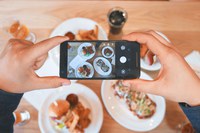Prairie Fare: Phones, tablets may spread germs
(Click an image below to view a high-resolution image that can be downloaded)
“You can take the new phone,” my husband said to me. We were on the way to the airport.
I put the palm-sized phone in my purse along with the charging cords.
I really had no idea how to use this little phone. I wasn’t exactly an “early adopter.”
On Sept. 10, 2001, my plane landed in Dallas, Texas. Our conference began the next morning.
The beginning of our conference was cut short when we were advised to go to our rooms and turn on the news. We all remember that day.
On the way to the elevator, a phone began ringing.
“Are you going to answer your phone?” someone asked.
I didn’t recognize the ring. I dug the phone from the bottom of my purse and looked at it. I wasn’t sure how to answer it.
Someone cracked it open for me. My family was checking on me. I was glad to have instant access to home.
I really did not want to get on a plane when I flew home almost a week later. I had my trusty phone, though.
I have had several phones since that time. My phone accompanies me all the time.
As my husband and I were having breakfast at a restaurant the other day, he made an observation.
“No one is talking with each other,” he said.
Many couples and families were seated at tables eating, but they were not conversing. They were intent on their phones.
Cell phones bring us the world of information and communication potential at our fingertips.
Can cell phones and other devices carry germs?
Yes, they can. However, research on foodborne illnesses linked to mobile devices is limited.
In a study published in 2020, researchers examined microbiological data from 56 studies conducted in 24 countries. Of those 56 studies, 54 identified bacteria on phones including staph, E. coli and bacillus species. They also noted fungus.
Some bacteria and viruses can survive for many days on surfaces. If you use your phone while eating a sandwich or other food containing protein and moisture, the germs may have the food they need to survive and grow. Your phone also is a warm environment.
Our hands certainly are in contact with phones, and when people talk on them, phones may encounter our faces. That puts germs in the proximity of our mouth and nose, where germs could enter our bodies.
Another researcher noted that 72% of people had never cleaned their cell phones.
According to the Food and Drug Administration, about half of people in their 2018 published study used phones or tablets when preparing food. Of those, only 37% washed their hands with soap after touching the device.
You might use a phone or a tablet when trying out a recipe. Sometimes phones go to “sleep” in the middle of reading a story or recipe, and you might need to tap the phone to wake it. Most phones allow you to change the settings to extend the amount of time the phone is “awake” so you do not need to touch the screen.
Avoid cross-contamination in your kitchen, whether you are using a cutting board, knife, phone or tablet.
How do you clean a phone? These are some tips I paraphrased from Verizon. Be sure to check the recommendations of your phone manufacturer and carrier.
- Before cleaning your device, turn it off and unplug it.
- Wash your hands before and after you clean your device. That means 20 seconds of scrubbing with soap and water.
- Find the ports on your phone. Avoid getting any moisture in the ports.
- Do not use soap and water on your phone.
- Do not use paper towels to wipe your phone. The paper may scratch your phone.
- Use an antibacterial alcohol-based wipe to clean your phone. Wring out the wipe if it is too damp. Or, spray a soft cloth with a disinfectant cleaner with 70% isopropyl alcohol.
- Don’t forget to clean the phone case and other accessories.
- Don’t share your technology with other people. That includes your phone, ear buds and other accessories.
- Try to sanitize your phone daily. Make it part of your routine, like brushing your teeth before bed.
I need help from all of you readers on an online survey about pulses, a major crop in the Midwest. If you are 18 or older and eat food on a regular basis, you are eligible to complete this online survey. You can complete it on a cell phone, tablet or a desktop computer.
As a thank you, you could win a prize, including gift cards and a variety of recipes, in a random drawing. Visit https://bit.ly/ndsupulsesurvey to complete the survey. We appreciate your help. Feel free to send it on to friends and family.
Julie Garden-Robinson, Ph.D., R.D., L.R.D., is a North Dakota State University Extension food and nutrition specialist and professor in the Department of Health, Nutrition and Exercise Sciences. Follow her on Twitter @jgardenrobinson).
NDSU Agriculture Communication – Nov. 17, 2022
Source: Julie Garden-Robinson, 701-231-7187, julie.garden-robinson@ndsu.edu
Editor: Elizabeth Cronin, 701-231-5391, elizabeth.cronin@ndsu.edu




